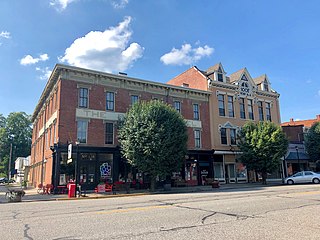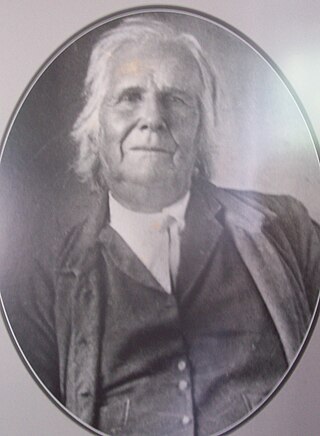Related Research Articles

Harrison County is located in the far southern part of the U.S. state of Indiana along the Ohio River. The county was officially established in 1808. Its population was 39,654 as of the 2020 United States Census. Its county seat is Corydon, the former capital of Indiana.

Clark County is a county in the U.S. state of Indiana, located directly across the Ohio River from Louisville, Kentucky. At the 2020 census, the population was 121,093. The county seat is Jeffersonville. Clark County is part of the Louisville/Jefferson County, KY–IN Metropolitan Statistical Area.

The Miami are a Native American nation originally speaking one of the Algonquian languages. Among the peoples known as the Great Lakes tribes, they occupied territory that is now identified as north-central Indiana, southwest Michigan, and western Ohio. The Miami were historically made up of several prominent subgroups, including the Piankeshaw, Wea, Pepikokia, Kilatika, Mengakonkia, and Atchakangouen. In modern times, Miami is used more specifically to refer to the Atchakangouen. By 1846, most of the Miami had been forcefully displaced to Indian Territory. The Miami Tribe of Oklahoma are the federally recognized tribe of Miami Indians in the United States. The Miami Nation of Indiana, a nonprofit organization of descendants of Miamis who were exempted from removal, have unsuccessfully sought separate recognition.

Corydon is a town in Harrison Township, Harrison County, Indiana. Located north of the Ohio River in the extreme southern part of the U.S. state of Indiana, it is the seat of government for Harrison County. Corydon was founded in 1808 and served as the capital of the Indiana Territory from 1813 to 1816. It was the site of Indiana's first constitutional convention, which was held June 10–29, 1816. Forty-three delegates convened to consider statehood for Indiana and drafted its first state constitution. Under Article XI, Section 11, of the Indiana 1816 constitution, Corydon was designated as the capital of the state, which it remained until 1825, when the seat of state government was moved to Indianapolis. In 1863, during the American Civil War, Corydon was the site of the Battle of Corydon, the only official pitched battle waged in Indiana during the war. More recently, the town's numerous historic sites have helped it become a tourist destination. A portion of its downtown area is listed in the National Register of Historic Places as the Corydon Historic District. As of the 2010 census, Corydon had a population of 3,122.

Mauckport is a town in Heth Township, Harrison County, Indiana, along the Ohio River. The population was 81 at the 2010 census.

New Amsterdam is a town located in Washington Township, Harrison County, Indiana, United States, along the Ohio River. As of the 2020 census, the city population was 12. As of the 2020 Census, New Amsterdam was the smallest city, town, or Census Designated Place in the state of Indiana. River Forest was the smallest in 2010 when it had 22, but had risen to 26. New Amsterdam now officially became the smallest town in Indiana with the population being 12, down from 27 in 2010.

Vevay is a town located in Jefferson Township and the county seat of Switzerland County, Indiana, United States, along the Ohio River. The population was 1,683 at the 2010 census.

The Indiana Territory, officially the Territory of Indiana, was created by an organic act that President John Adams signed into law on May 7, 1800, to form an organized incorporated territory of the United States that existed from July 4, 1800, to December 11, 1816, when the remaining southeastern portion of the territory was admitted to the Union as the state of Indiana. The territory originally contained approximately 259,824 square miles (672,940 km2) of land, but its size was decreased when it was subdivided to create the Michigan Territory (1805) and the Illinois Territory (1809). The Indiana Territory was the first new territory created from lands of the Northwest Territory, which had been organized under the terms of the Northwest Ordinance of 1787. The territorial capital was the settlement around the old French fort of Vincennes on the Wabash River, until transferred to Corydon near the Ohio River in 1813.

Morgan's Raid was a diversionary incursion by Confederate cavalry into the Union states of Indiana, Kentucky, Ohio, and West Virginia during the American Civil War. The raid took place from June 11 to July 26, 1863. It is named for the commander of the Confederate troops, Brigadier General John Hunt Morgan. Although it caused temporary alarm in the North, the raid failed.

The Battle of Corydon was a minor engagement that took place July 9, 1863, just south of Corydon, which had been the original capital of Indiana until 1825, and was the county seat of Harrison County. The attack occurred during Morgan's Raid in the American Civil War as a force of 2,500 cavalry invaded the North in support of the Tullahoma Campaign. It was the only pitched battle of the Civil War that occurred in Indiana, and no battle has occurred within Indiana since.

During the 18th and early 19th centuries, the French, British and U.S. forces built and occupied a number of forts at Vincennes, Indiana. These outposts commanded a strategic position on the Wabash River. The names of the installations were changed by the various ruling parties, and the forts were considered strategic in the French and Indian War, the American Revolutionary War, the Northwest Indian War and the War of 1812. The last fort was abandoned in 1816.

Bethlehem is an unincorporated community in Bethlehem Township, Clark County, Indiana, United States, twenty-five miles up the Ohio River from Louisville, Kentucky. It was platted in 1812 and according to WPA records was presumably named for Bethlehem, Pennsylvania. Its first office was established on March 6, 1816. The community's post office is popular around Christmas with those wanting to have a Bethlehem postmark on Christmas letters and cards.

PS Alice Dean, which had a capacity of 880 tons, was a side-wheel, wooden-hulled packet steamer. It was launched from Cincinnati, Ohio, United States, in 1863, running a scheduled route between Cincinnati and Memphis, Tennessee. Its captain was James H. Pepper.

The Swan's Landing Archeological Site is an archaeological site from the Early Archaic period in Harrison County, Indiana, United States. Located along the Ohio River, it has been extensively damaged by modern activity, but it is still one of the most important sites for its time period in North America. It has been designated a historic site because of its archaeological value.

Washington Township is the smallest of twelve townships in Harrison County, Indiana. As of the 2010 census, its population was 522 and it contained 237 housing units.

Dennis Pennington was a farmer and a stonemason who became known for his many years in public office as an early legislator in the Indiana Territory and in Indiana's General Assembly as a representative of Harrison County, Indiana. Pennington, a member of the Whig Party, became the first speaker of the Indiana territorial legislature's lower house in 1810, served as the territory's census enumerator in 1815, and represented Harrison County as one of its five delegates to the constitutional convention of 1816. Pennington was the first speaker of the Indiana Senate, and served in the state legislature for eighteen years, which included five years in the Indiana House of Representatives and thirteen years in the Indiana Senate. His major political contributions relate to his strong opposition to slavery. Pennington ran unsuccessfully for Indiana's Lieutenant Governor in 1825. In addition to his service in the state legislature, Penning was a Harrison County sheriff and a justice of the peace, a trustee of Indiana University, and a member of the Grand Lodge of Indiana. He also supervised construction of the limestone courthouse that served as Indiana's first state capitol building in Corydon, Indiana. The historic Old Capitol, the seat of state government from 1816 to 1825, is one of his most enduring legacies. Fondly remembered as "Old Uncle Dennis" or "Father Pennington," he was known for his common sense and strong character and became one of Harrison County's most influential citizens.

The Vincennes Trace was a major trackway running through what are now the American states of Kentucky, Indiana, and Illinois. Originally formed by millions of migrating bison, the Trace crossed the Ohio River near the Falls of the Ohio and continued northwest to the Wabash River, near present-day Vincennes, before it crossed to what became known as Illinois. This buffalo migration route, often 12 to 20 feet wide in places, was well known and used by American Indians. Later European traders and American settlers learned of it, and many used it as an early land route to travel west into Indiana and Illinois. It is considered the most important of the traces to the Illinois country.

During the War of 1812, Indiana Territory was home to several conflicts between the United States territorial government and partisan Native American forces backed by the British in Canada. The Battle of Tippecanoe, months before the war officially began, was one of the catalysts that caused the war. The fighting in the territory is often considered a continuation of Tecumseh's War, and the final struggle of the Sixty Years' War.
The Indiana Rangers, also known as the Indiana Territorial Mounted Rangers, were a mounted militia formed in 1807 and operated in the early part of the 19th century to defend settlers in Indiana Territory from attacks by Native Americans. The rangers were present at the Battle of Tippecanoe, and served as auxiliaries to the army during the War of 1812. At the peak of their activities they numbered over 400 men.
Tobacco Landing is an unincorporated community in Harrison County, Indiana, in the United States.
References
- ↑ Crenshaw, Gwendolyn J. Bury Me in a Free Land: The Abolitionist Movement in Indiana, 1816-1865. Indiana Historical Bureau, 1993. p28
- ↑ Roose, William (1911). "Indiana's Birthplace: A History of Harrison County, Indiana". Google Books. Tribune Company, Printer, 1911. Retrieved 2 December 2016.